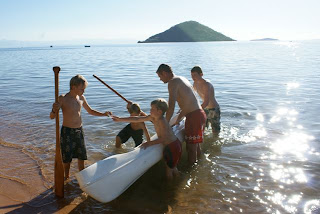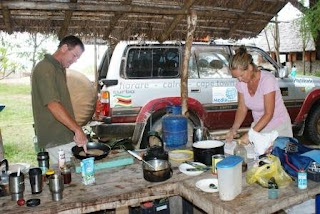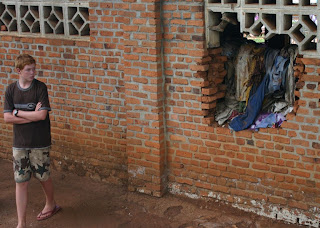Before I begin, I need to apologise for the extreme tardiness of this blog . The combination of remote travel over the past 6 weeks which has presented very few opportunities for internet or electricity, plus an unaccountable inertia on my part, has meant a loooong delay in getting this piece written. My sincere apologies. But at last, here it is...
As if seeing the chimpanzees wasn’t enough good fortune. How do we continue to be so blessed on this trip? It had never occurred to me that we would get to see gorillas: the cost alone, at US$500 pp, is prohibitively expensive for most backpackers’ budget. In spite of the cost, however, the lure of seeing mountain gorillas (of which there are a mere 720 remaining in the world) still attracts plenty of tourists to Rwanda and Uganda. So much so, in fact, that there is a waiting list several months’ long for obtaining a permit. Not having booked months in advance, it didn’t enter our heads that a visit to the gorillas was even a viable thought. Not until we crossed the border from Uganda into Rwanda, that is...
Suddenly finding ourselves in a Host Country of these magnificent creatures, where every other hotel, motel and hostel is called Gorilla Lodge, Gorilla Nest Inn or Silverback View Hotel did the thought enter our minds: how silly to be here, Right Here, in the heart of Gorilladom and not at least try to see them. So we decided to test Fate and enquire at the National Parks office. After all, it was low season and still technically the rainy season – a factor which severely reduces tourists’ chances of seeing the gorillas. We didn’t expect a positive answer, therefore we were not going to be disappointed. But at least we would have tried.
We stopped off at Ruhengeri and enquired. The office not only had available permits, but several of them, and for every day of the remaining week we were around. On hearing this news, for an instant I couldn’t breathe. Then my insides burnt hot with the desire to see the gorillas. I could not believe that it was possible, yet here we were, confronted with the decision Should We Go or Not. Suddenly, the $500 fee lost its importance, knowing that however much it is, it would be more than worth it. How can one weigh up the price of a Once in a Lifetime experience such as this? I waited to see what the others would decide, holding my breath with anticipation. But when Nicky asked me what I thought, I blurted out my answer. YES!! I really do want to go! Gus and Nicky have already seen mountain gorillas, so it was up to Robert and Big Max. Fortunately, they both ended up agreeing to seize this unique opportunity and so we bought 3 permits and prepared ourselves for a Once In a Lifetime treat!
Fast forward to Saturday 2nd May...The dawn sky shone brilliantly on the surrounding volcanoes, as if in apology for the glum, cloudy day we’d had the previous day. It was a good omen, I knew it! Robert, Max and I drove from the camp (to a chorus of farewells from the rest of the gang) to the National Parks HQ. We’d given a lift to three others: Seth from the States and Belgians Annike & Kris, who also ended up in our tracking group. We were ‘assigned’ the Amhora Group of gorillas (of which there are 16 family members). An aptly named group, given that they were the first gorilla family discovered in the forest after the Rwandan genocide: Amhora means Unity in the Kinyarwanda language. Our guide was a young and enthusiastic man named Oliver, who knew every single gorilla in all seven of the groups that have been habituated on this side of the volcanoes. My toes tingled in anticipation and I was impatient to get going. But we still had to drive out to the starting point, about 50 minutes away and then spend another 40 minutes walking through rural villages and fields, before finally arriving at the start of the forest. It began in wild bamboo, but changed shortly to thick forest undergrowth that climbed upwards, becoming increasingly steeper as we headed up the unrelenting volcano. This was no easy stroll, it was hard work as we fought entangling vines, long sharp grasses, giant stinging nettles I’ve never before encountered the size, or sting, of and the most hostile of all, the aggressive, biting Army ants. I didn’t mind any of it one bit, however, because I knew we would be richly rewarded. Which indeed we inevitably were.
After a hard hour’s climb, the trackers (men from the local community who spend every single day with this particular group of gorillas) called down to us that they had located the forest dwellers. My heart pounded as I scanned the mountainside, searching desperately to catch a glimpse of one of them. Before I knew what was happening, however, I walked into the backs of our group who had stopped abruptly, on account of the sudden appearance from seemingly nowhere of an adult silverback! Totally unperturbed by us, he nonchalantly loped in front of us and went ahead to find another bush where he could uproot a tasty bunch of the wild celery plant that grows abundantly on the mountainside. We were astounded! With mouths agape at our first and unexpectedly close encounter with this huge furry beast, some of us tried to suppress the nervous, incredulous giggle that welled up. We were told very strictly that no noise or sudden movement was allowed in their presence and as much as was possible, we had to maintain a 7m distance from the gorillas. This stipulation is less a security factor for us, rather more a health consideration for the gorillas, who are vulnerable to human germs.
As we continued our almost-vertical scramble up the mountain, we came to a natural clearing, where Lo and Behold! Our expectations were fully realised at the sight of the core members of the Amhora family of gorillas!! The bush was still incredibly thick in parts, so we continued to be surprised by sudden appearances of these huge creatures. I had my own special experience when – being at the back of the group – a mother gorilla had followed after us through the leafy tunnel into the clearing, without our knowing. Without warning or fuss, she simply carried on her way with baby on her back, right past me. I had no idea what to do other than put my head down in a submissive posture, making sure not to make eye contact (I’d learnt that from the Dian Fossey movie!), but the space in the thicket was tight and didn’t allow for space off the path and she brushed her strong body against my legs. A small part of me was terrified, but not because I thought she would turn on me, rather because I felt I had crossed a sacrilegious boundary by making physical contact with a wild gorilla, however unwittingly. Mostly, though, I bubbled with euphoria and the amazed awe of having been so close to one of these special, rare creatures. The best bit was seeing the 10 month old baby gorilla – as cutely clichéd as all the magazine photos portray – make eye contact with me as it passed by, turning its head to maintain its bewildered gaze upon this hairless creature that grinned so stupidly at it! It was so unutterably cute, it took an enormous amount of self-control not to put my hand out to touch it!
Once having located a gorilla family, the deal is you get to spend only one hour with them. For many obvious reasons, this is clearly a good stipulation for the gorillas’ sakes. As the observer, however, the frustration lay in the fact that 60 minutes of absorbed focus and awe whittled down to what felt more like 6 minutes! We stood up the mountain from them constantly amused and amazed by at the antics of the baby gorilla: playing tag with its young ‘toddler’ sister, rolling over, falling backwards down the slope, climbing over adult relatives who were too busy eating shoots to pay any attention, and hanging upside down from the branches of a small bush. The other gorillas, the adults and sub-adults, concentrated solely on eating; we were fortunate enough to have found the group stationary at snack time. Watching the way these massive, hairy beasts delicately stripped off the bark of stalks before eating them, the way they itched themselves, the way they communicated between themselves, as well as with us, was a constant source of wonder. In so many ways, gorillas appear to mimic us humans: the raise of an eyebrow, a sideways glance, the tender touch of affection, the selective appraisal of which shoot to eat for lunch. So uncannily human. And yet still intrinsically wild and beast-like. We were all fascinated.
I was also extremely conscious of the fact that what we were experiencing here was something so fragile, so tenuous. These mountain gorillas – blissful as they currently are – are incredibly vulnerable. Not only do they live in a habitat that happens to be a live volcano, but also within an area of extreme tension and human aggression, sandwiched between volatile DRC, Rwanda and Uganda. Their long-term future is not rosy. We were phenomenally privileged to have shared an hour in the lives of these wondrous animals. It was very hard to tear ourselves away from them. But the visions and memories of each of the Amhora family members are strong. May they always remain so. Most fortuitously for us, one of our group is a professional cameraman – our very own Rob Adams! I’d just like to end by saying a special Thank You to Robert for being the one to forgo a degree of intimacy with the gorillas, as his hour’s experience of them was witnessed largely through the lens of a camera – for the benefit of us all. You can see his stunning short video through our blog site connection............. Great job, Robert, thanks so much!
























































